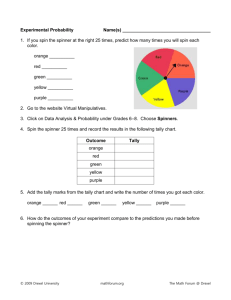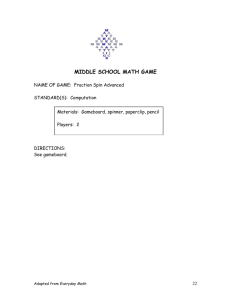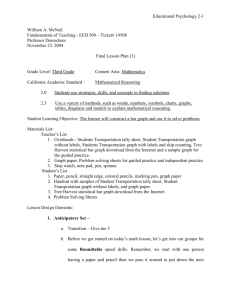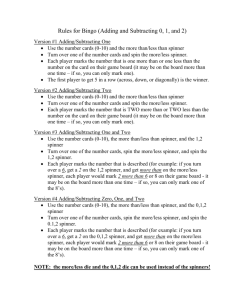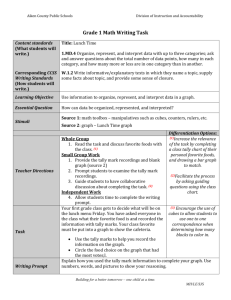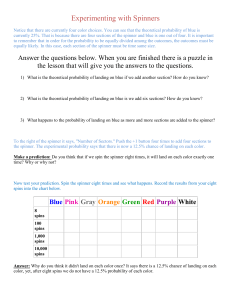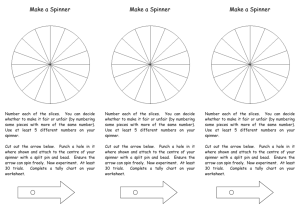What`s In Your Backpack and Where Did It
advertisement
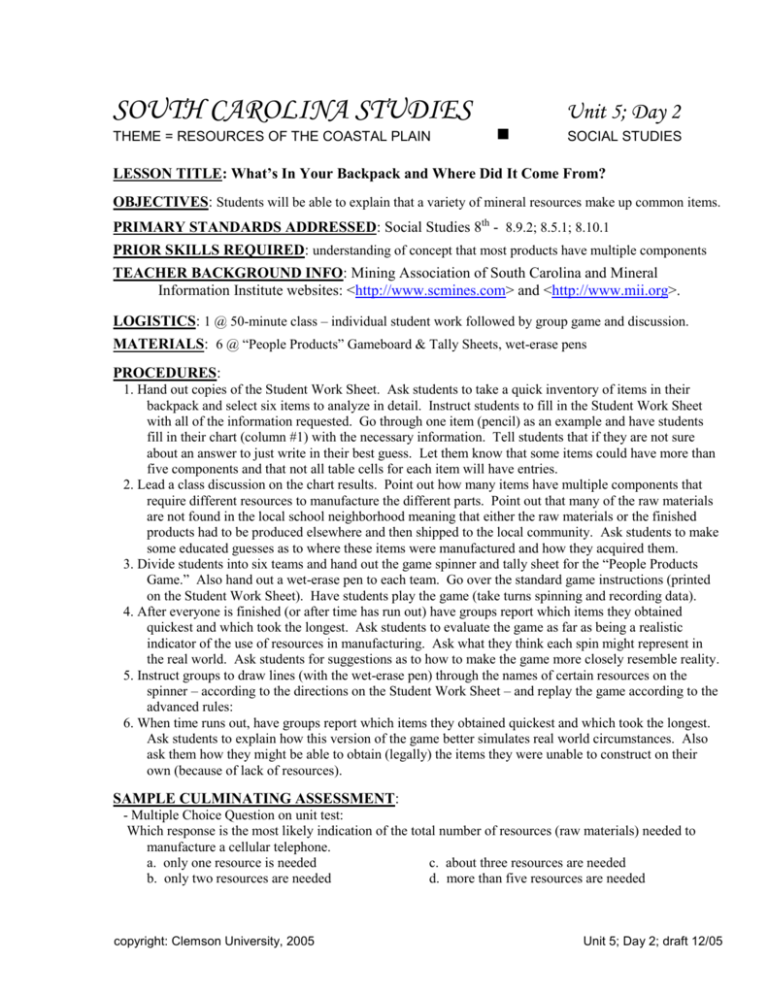
SOUTH CAROLINA STUDIES THEME = RESOURCES OF THE COASTAL PLAIN Unit 5; Day 2 SOCIAL STUDIES LESSON TITLE: What’s In Your Backpack and Where Did It Come From? OBJECTIVES: Students will be able to explain that a variety of mineral resources make up common items. PRIMARY STANDARDS ADDRESSED: Social Studies 8th - 8.9.2; 8.5.1; 8.10.1 PRIOR SKILLS REQUIRED: understanding of concept that most products have multiple components TEACHER BACKGROUND INFO: Mining Association of South Carolina and Mineral Information Institute websites: <http://www.scmines.com> and <http://www.mii.org>. LOGISTICS: 1 @ 50-minute class – individual student work followed by group game and discussion. MATERIALS: 6 @ “People Products” Gameboard & Tally Sheets, wet-erase pens PROCEDURES: 1. Hand out copies of the Student Work Sheet. Ask students to take a quick inventory of items in their backpack and select six items to analyze in detail. Instruct students to fill in the Student Work Sheet with all of the information requested. Go through one item (pencil) as an example and have students fill in their chart (column #1) with the necessary information. Tell students that if they are not sure about an answer to just write in their best guess. Let them know that some items could have more than five components and that not all table cells for each item will have entries. 2. Lead a class discussion on the chart results. Point out how many items have multiple components that require different resources to manufacture the different parts. Point out that many of the raw materials are not found in the local school neighborhood meaning that either the raw materials or the finished products had to be produced elsewhere and then shipped to the local community. Ask students to make some educated guesses as to where these items were manufactured and how they acquired them. 3. Divide students into six teams and hand out the game spinner and tally sheet for the “People Products Game.” Also hand out a wet-erase pen to each team. Go over the standard game instructions (printed on the Student Work Sheet). Have students play the game (take turns spinning and recording data). 4. After everyone is finished (or after time has run out) have groups report which items they obtained quickest and which took the longest. Ask students to evaluate the game as far as being a realistic indicator of the use of resources in manufacturing. Ask what they think each spin might represent in the real world. Ask students for suggestions as to how to make the game more closely resemble reality. 5. Instruct groups to draw lines (with the wet-erase pen) through the names of certain resources on the spinner – according to the directions on the Student Work Sheet – and replay the game according to the advanced rules: 6. When time runs out, have groups report which items they obtained quickest and which took the longest. Ask students to explain how this version of the game better simulates real world circumstances. Also ask them how they might be able to obtain (legally) the items they were unable to construct on their own (because of lack of resources). SAMPLE CULMINATING ASSESSMENT: - Multiple Choice Question on unit test: Which response is the most likely indication of the total number of resources (raw materials) needed to manufacture a cellular telephone. a. only one resource is needed c. about three resources are needed b. only two resources are needed d. more than five resources are needed copyright: Clemson University, 2005 Unit 5; Day 2; draft 12/05 SOUTH CAROLINA STUDIES THEME = RESOURCES OF THE COASTAL PLAIN Unit 5; Day 2 SOCIAL STUDIES STUDENT WORK SHEET LESSON TITLE: What’s In Your Backpack and Where Did It Come From? A. Select six items from your backpack to analyze in detail. Write the item name at the top of each column. Fill in the table below as best you can. If you are not sure about an answer, write down your best guess. DETAILED BACKPACK ITEM ANALYSIS COMPONENT #2 COMPONENT #1 component name made from what? COMPONENT #5 COMPONENT #4 COMPONENT #3 ITEM #1 component name made from what? ITEM #2 ITEM #3 ITEM #4 ITEM #5 ITEM #6 where/how obtained? component name made from what? where/how obtained? where/how obtained? component name made from what? where/how obtained? component name made from what? where/how obtained? copyright: Clemson University, 2005 Unit 5; Day 2; draft 12/05 B. Cut out ‘Resource Wheel’, tally sheet, and spinner to make gameboard (or use prepared one). Follow the standard directions below to play the ‘People Products Game’ [available on website <http://www.mii.org>]. [Modified from “What’s Under Your Feet” – U.S. Geological Survey Earth Science for Everyone Activity Book] STANDARD DIRECTIONS To Play: You will need a gameboard spinner, a tally sheet, and a wet-erase pen. One team member will have to count the total number of spins required to complete each item on the tally sheet list by making marks on a separate sheet of paper. The other team members should take turns spinning the spinner and recording the resource (that the arrow points to) by filling in the appropriate circle(s) on the tally sheet. Whenever you fill in all the circles for a particular item, you have ‘acquired’ that item. When an item is ‘acquired’, make a check mark on that item with the pen and write the number of spins required to obtain that item next to the check mark. The game ends when time runs out or all items have been acquired. ADVANCED RULES Follow the “Standard Directions” except for this one additional instruction: Draw a line (with the weterase pen) through the names of certain resources on the spinner – according to your assigned group. - GROUP 1: cross out ‘oil’, ‘natural gas’, ‘clay’, ‘salts’, and ‘sulfur’ - GROUP 2: cross out ‘silver’, ‘gold’, ‘tin’, ‘lead’, ‘zinc’, ‘nickel’, ‘copper’, ‘chromium’ - GROUP 3: cross out ‘rare earths’, ‘iron’, ‘aluminum’, ‘titanium’, ‘molybdenum’, ‘tungsten’ - GROUP 4: cross out ‘coal’, ‘asbestos’, ‘limestone’, ‘gypsum’, ‘phosphate’, ‘silica sand’ - GROUP 5: cross out ‘mercury’, ‘lead’, ‘zinc’, ‘gems’, ‘asbestos’, ‘tin’ - GROUP 6: cross out ‘coal’, ‘natural gas’, ‘oil’, ‘aluminum’, ‘copper’, ‘iron’ Whenever the spinner points to an item you have crossed out, you cannot count that item and cannot fill in any circles on the tally sheet (but you should count the spin anyway in your total). copyright: Clemson University, 2005 Unit 5; Day 2; draft 12/05 SOUTH CAROLINA STUDIES THEME = RESOURCES OF THE COASTAL PLAIN Unit 5; Day 2 SOCIAL STUDIES TEACHER ANSWER KEY LESSON TITLE: What’s In Your Backpack and Where Did It Come From? 1. Hand out copies of the Student Work Sheet. Ask students to take a quick inventory of items in their backpack and select six items to analyze in detail. Instruct students to fill in the Student Work Sheet with all of the information requested. Go through one item (pencil) as an example and have students fill in their chart (column #1) with the necessary information. Most students will have backpacks or book bags, or even purses that contain a variety of objects suitable for analysis. The standard #2 pencil will be composed of four components (wood, graphite[pencil lead], rubber [eraser], and a metal sleeve [to hold the eraser to the pencil]. Some pencils may also have plastic pieces. Note that a ‘component’ as used here is a more a description of the function of the item than what it is composed of. Answers may vary, but one example of the analysis of a pencil might produce the following result: Component Name = wooden tube Made from what = wood Where/how obtained = cut down trees Component Name = pencil lead Made from what = graphite Where/how obtained = mining of mineral Component Name = eraser Made from what = ‘rubber’ Where/how obtained = synthetic from petroleum Component Name = metal sleeve Made from what = aluminum Where/how obtained = mining of mineral Tell students that if they are not sure about an answer to just write in their best guess. Let them know that some items could have more than five components and that not all table cells for each item will have entries. For some items, students will not know what the components are made from or where or how they are obtained. In such cases, students should make their best guess and enter the answer along with a question mark. The important concept here is recognizing that most common items require a complex set of resources from different places and that much assembly is required. The exact details are interesting, but not critical. 2. Lead a class discussion on the chart results. Point out how many items have multiple components that require different resources to manufacture the different parts. Point out that many of the raw materials are not found in the local school neighborhood meaning that either the raw materials or the finished products had to be produced elsewhere and then shipped to the local community. Ask students to make some educated guesses as to where these items were manufactured and how they acquired them. This discussion should be a good way to highlight the economy of the local community. It is also a chance to reinforce concepts of trade and the use of money as an intermediary to exchange commodities. For many items, it is impossible to tell exactly where they were made (assembled), but most students have items that were ‘made in China’ or in some other foreign country. In the case of a pencil, it is usually impossible to tell what company manufactured it or how it got into the local store, but students may be able to infer some data based on their general geographical knowledge. 3. Divide students into six teams and hand out the game spinner and tally sheet for the “People Products Game.” Also hand out a wet-erase pen to each team. Go over the standard game instructions (printed on the Student Work Sheet). Have students play the game (take turns spinning and recording data). You may wish to set a time limit for this game, as spinners are unpredictable and some items may never be completely ‘acquired’. Some observant students may note that this ‘game’ is somewhat outdated (for example the “Stereo” still includes mention of vinyl records, needles, and tapes which some students may never have used or even seen. You can use this opportunity to reinforce the concept of change through time in regards to consumer goods and technology. copyright: Clemson University, 2005 Unit 5; Day 2; draft 12/05 4. After everyone is finished (or after time has run out) have groups report which items they obtained quickest and which took the longest. Ask students to evaluate the game as far as being a realistic indicator of the use of resources in manufacturing. Ask what they think each spin might represent in the real world. Ask students for suggestions as to how to make the game more closely resemble reality. In order to obtain resources in the real world, it is necessary to purchase them (usually with money or sometimes through barter). The money comes from personal investment of time and effort (what we call work). So each spin of the pointer could represent a unit of work or a unit of time. The main problem with this game is that each resource is equally likely to be selected on any given spin, and that the same unit of work, or time, can ‘purchase’ different products [which students should recognize do NOT have the same value – i.e. a pound of clay vs. a pound of gold]. One simple way to improve the realism of the game would be to make the ‘gold’ space very small and the ‘clay’ space much larger. 5. Instruct groups to draw lines (with the wet-erase pen) through the names of certain resources on the spinner – according to the directions on the Student Work Sheet – and replay the game according to the advanced rules. Again, you may wish to set a time limit, because many spins will land on crossed out items and not ‘acquire’ anything. 6. When time runs out, have groups report which items they obtained quickest and which took the longest. Ask students to explain how this version of the game better simulates real world circumstances. Also ask them how they might be able to obtain (legally) the items they were unable to construct on their own (because of lack of resources). Answers will vary among groups. Some groups will find that they cannot obtain certain items because they do not have access to the necessary raw materials. Such situations should make obvious the need for trade among various partners each of whom has access to certain raw materials and not others. Stealing resources should not be an option. SAMPLE CULMINATING ASSESSMENT: - Multiple Choice Question on unit test: Correct answer is ‘d’ Which response is the most likely indication of the total number of resources (raw materials) needed to manufacture a cellular telephone. a. only one resource is needed c. about three resources are needed b. only two resources are needed d. more than five resources are needed Although cellular phones come in many different makes and models, students should realize that many different components make up the final product, each of which requires different raw materials or resources. Cell phones require plastic (oil or petroleum products), metals (wires and electrical connections), paint pigments for various colors (from minerals), LCD screen (requires additional minerals) and several others. copyright: Clemson University, 2005 Unit 5; Day 2; draft 12/05
